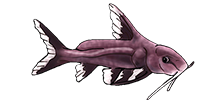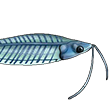Scobinancistrus pariolispos [L-48] + [L-368]?
Scobinancistrus pariolispos [L-48] + [L-368]?
Are both L-48 and L-368 [from different rivers?] actually the same species? And is there any L-48 with black body and white spots? If they are different how do you id them?[/i]
Scobinancistrus auratus is my favorite pleco ^_^
- MatsP
- Posts: 21038
- Joined: 06 Oct 2004, 13:58
- My articles: 4
- My images: 28
- My cats species list: 117 (i:33, k:0)
- My aquaria list: 10 (i:8)
- My BLogs: 4 (i:0, p:164)
- Spotted: 187
- Location 1: North of Cambridge
- Location 2: England.
L-numbers are not scientific descriptions, and as such will do not necessarily give the same number to the same specie. L48 MAY be the same specie as L368 - but there's nothing to say either, that they actually ARE teh same specie.
There's more than one example of fish that look almost identical, but aren't the same specie. "False" and "real" neon tetra's would be one example...
Until some scientist comes up with a scientific paper descibing either of (or both) the L-numbers, it will remain impossible to say whether they are or are not [and even after some scientist has described them, some other scientist may come up with a different view!]
Looking at the pictures in the Cat-eLog, the L368 looks like it's got bigger spots, but maybe that's just a case of what age the photo was taken.
Edit: I'd like to point out that EVEN if they are the same species, I'd treat them as different if they look different - just like some species of certain african rift-lake cichlids are not supposed to be crossed together when they are from different locations.
--
Mats
There's more than one example of fish that look almost identical, but aren't the same specie. "False" and "real" neon tetra's would be one example...
Until some scientist comes up with a scientific paper descibing either of (or both) the L-numbers, it will remain impossible to say whether they are or are not [and even after some scientist has described them, some other scientist may come up with a different view!]
Looking at the pictures in the Cat-eLog, the L368 looks like it's got bigger spots, but maybe that's just a case of what age the photo was taken.
Edit: I'd like to point out that EVEN if they are the same species, I'd treat them as different if they look different - just like some species of certain african rift-lake cichlids are not supposed to be crossed together when they are from different locations.
--
Mats
I am aware of the fact that L-numbers has nothing to do with description of species. I guess there is nothing new regarding Scobinancistrus pariolispos though.
Anyway the local shop has 4 sunshine pleco-like specimens that look mostly similar to parios, but two has white spots on black ground color, while the other two has yellowish/orangish spots on brownish grown color. No L-number is given on them, so I do not know what they are exactly .
.
Anyway the local shop has 4 sunshine pleco-like specimens that look mostly similar to parios, but two has white spots on black ground color, while the other two has yellowish/orangish spots on brownish grown color. No L-number is given on them, so I do not know what they are exactly
Scobinancistrus auratus is my favorite pleco ^_^




